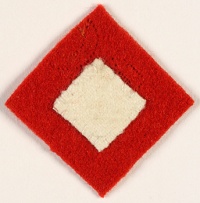The 45th Royal Tank Regiment was an armoured regiment of the British Territorial Army that fought at the Battle of Alamein during World War II and continued to serve during the 1950s.
The 43rd Royal Tank Regiment was an armoured regiment of the British Army's Royal Armoured Corps that tested and demonstrated specialised Armoured Fighting Vehicles during World War II.
The 51st Royal Tank Regiment was an armoured regiment of the British Territorial Army that fought in the Tunisian and Italian campaigns during World War II and continued to serve during the 1950s.
The 10th Armoured Brigade was a short-lived armoured brigade of the British Army in the Second World War. It had been converted in November 1941 from infantry battalions, but had never seen action and was disbanded in late 1943.

The 42nd Armoured Division was an armoured division of the British Army raised during the Second World War.

The King's Own Royal Regiment (Lancaster) was a line infantry regiment of the British Army. It served under various titles and fought in many wars and conflicts, including both the First and the Second World Wars, from 1680 to 1959. In 1959, the regiment was amalgamated with the Border Regiment to form the King's Own Royal Border Regiment.

The 144th Regiment Royal Armoured Corps was an armoured regiment of the British Army. Originally raised during World War II as a battalion of the East Lancashire Regiment it was later transferred to the Royal Armoured Corps. It fought in the campaign in North-West Europe, from June 1944 to May 1945.
The 33rd Army Tank Brigade was an armoured brigade formation of the British Army raised during the Second World War.

The 148th Regiment Royal Armoured Corps was an armoured regiment of the British Army's Royal Armoured Corps during World War II. It fought in the invasion of Normandy in 1944.
The 107th Regiment Royal Armoured Corps (King's Own) (107 RAC) was a tank regiment of the Royal Armoured Corps, raised by the British Army during the Second World War. The regiment served with distinction in North-west Europe from July 1944 to May 1945.
The 153rd Regiment Royal Armoured Corps was an armoured regiment of the Royal Armoured Corps, part of the British Army, and was raised during the Second World War. The regiment saw brief but intense action in the invasion of Normandy before being broken up to provide replacements to other units.
The 112th Regiment Royal Armoured Corps (Foresters) (112 RAC) was an armoured car regiment of the British Army's Royal Armoured Corps during the Second World War.
Brigadier Philip Ernest Bowden-Smith CBE, was a cavalry officer and later armoured commander of the British Army who served in the First World War and the Second World War. Described as 'one of the finest horsemen of his generation' he also represented Great Britain at the 1924 Olympic Games.
The 108th Regiment Royal Armoured Corps (The Lancashire Fusiliers) (108 RAC) was an armoured regiment of the British Army's Royal Armoured Corps during World War II.
109th Regiment Royal Armoured Corps (The Lancashire Fusiliers) (109 RAC) was an armoured regiment of the British Army's Royal Armoured Corps during World War II.
The 143rd Regiment Royal Armoured Corps was a short-lived armoured regiment of the British Army's Royal Armoured Corps during World War II.
The 110th Regiment Royal Armoured Corps (Border Regiment) (110 RAC) was an armoured regiment of the British Army's Royal Armoured Corps raised during the Second World War.
The 111th Regiment Royal Armoured Corps (Manchester Regiment) (111 RAC) was an armoured regiment of the British Army, raised by the Royal Armoured Corps during the Second World War.

The 34th Armoured Brigade was an armoured brigade of the British Army that saw active service in the Second World War. It was formed in 1941 as the 34th Army Tank Brigade and subsequently redesignated as the 34th Tank Brigade in February 1945 and became part of the 79th Armoured Division. It was equipped with Churchill tanks and provided close support for assaults by the infantry. During the fighting in North-west Europe from July 1944 to May 1945 the brigade served with both the First Canadian Army and the British Second Army. The brigade was disbanded in early 1946.
The 142nd (Suffolk) Regiment Royal Armoured Corps was an armoured regiment of the British Army's Royal Armoured Corps that was raised in World War II and saw active service. The regiment served in the final stages of the North African Campaign at Tunisia and later served during the Italian Campaign from 1943 until early 1945 when it was disbanded.




